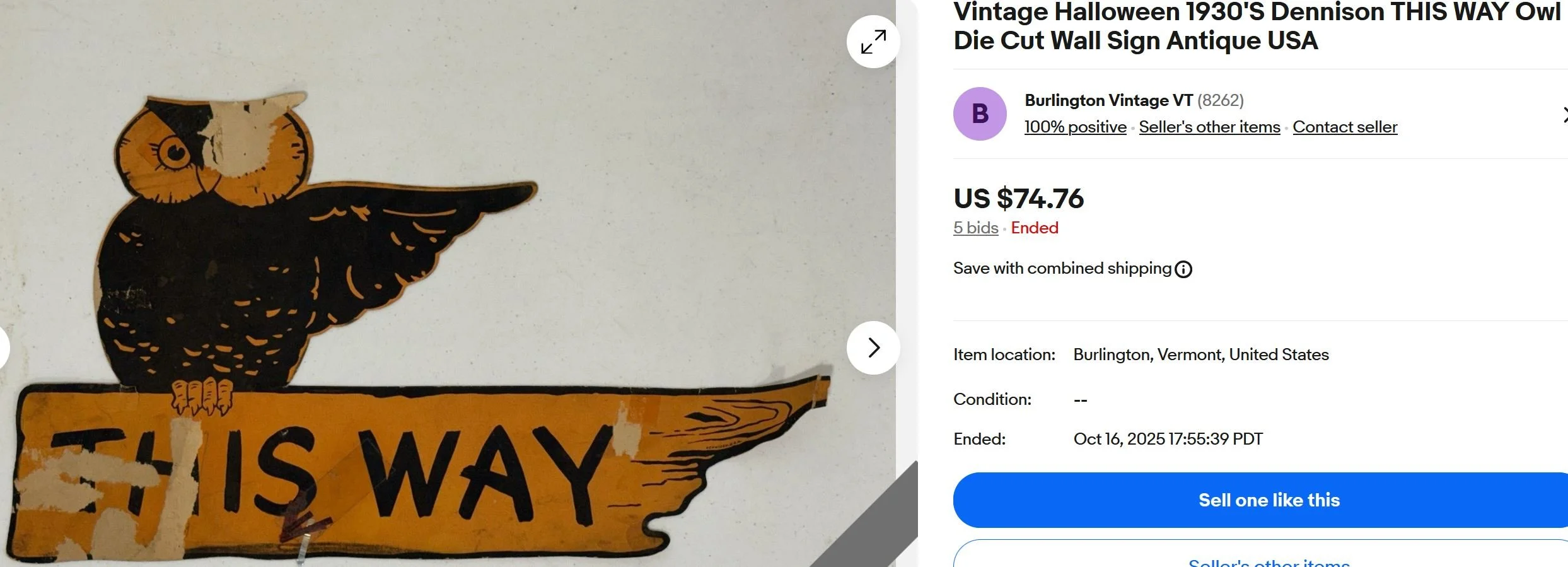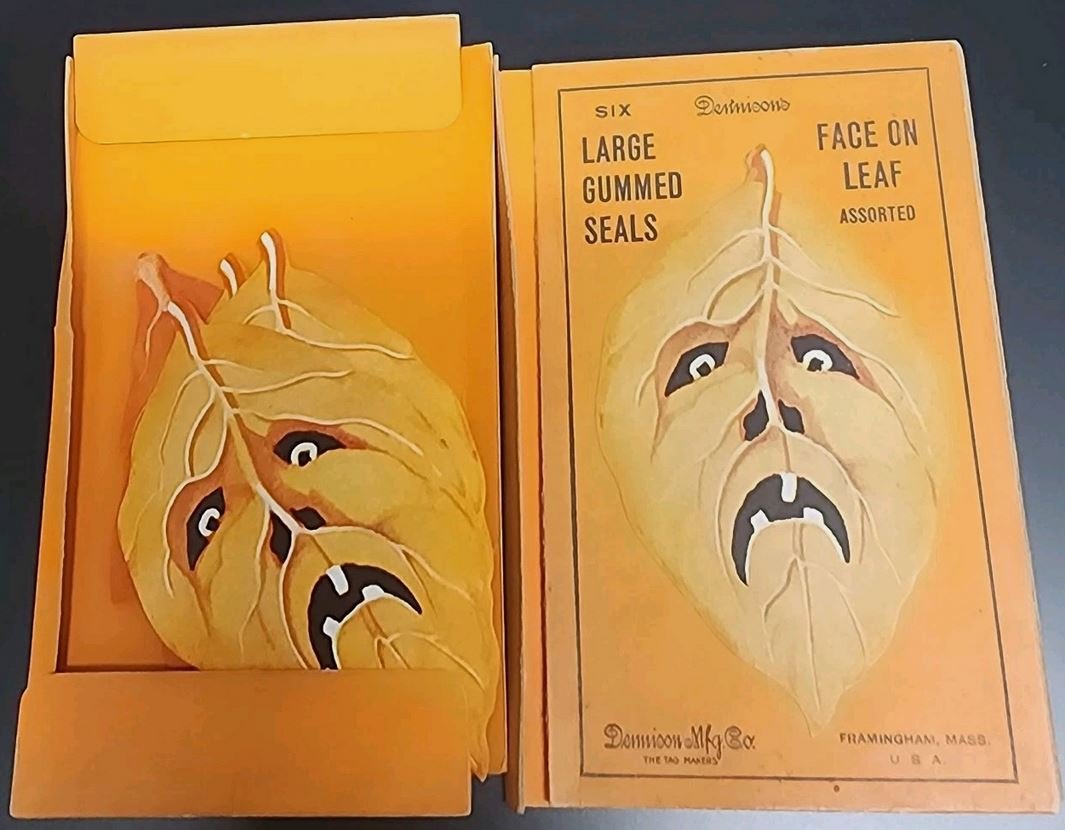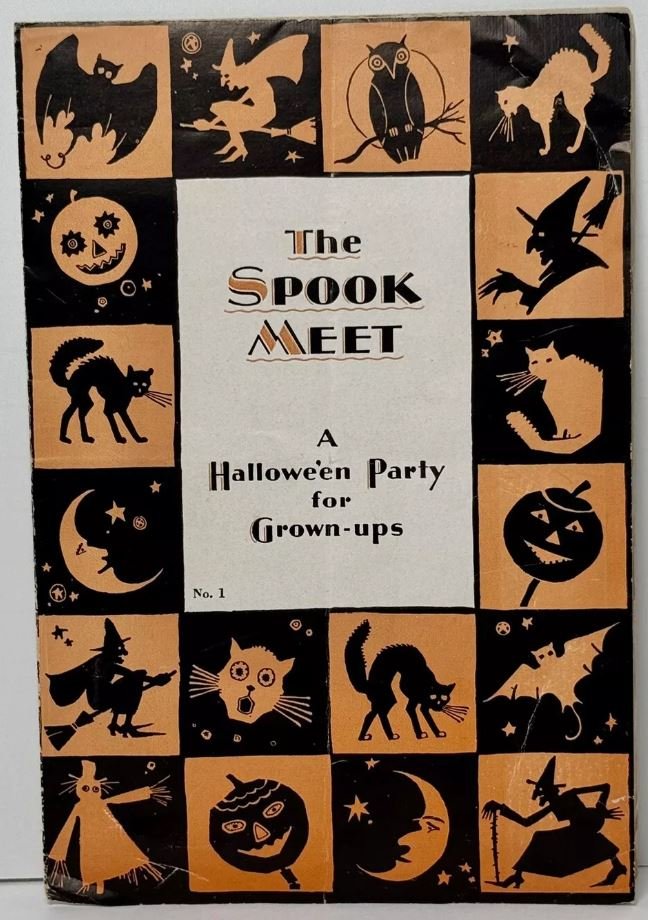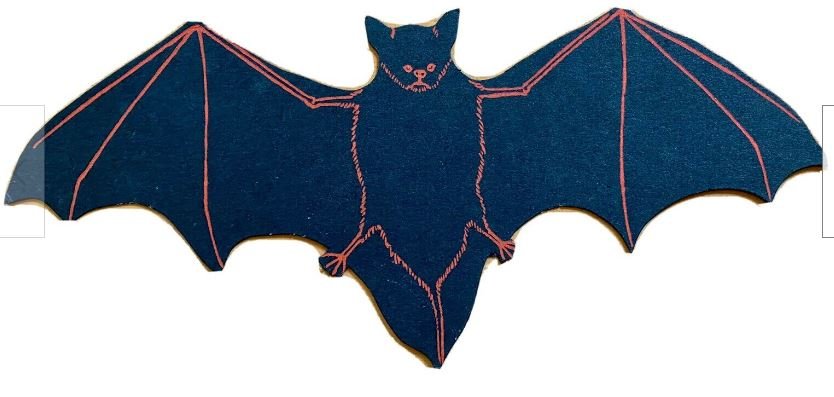Blog
BOXED SET Of 5 Antique Vintage Halloween Witch Silhouettes Dennison 1920s
Even though boxed Dennison items are having another turn in the sun, this result surprised me. The set contains only 5 of the original 18 illuminated silhouettes. The front example is incomplete and the box has condition issues. Yet, it still brought $355. If someone wants my complete and mint set shown on page 252 top/left, it can be yours for $750.
Vintage Halloween Dennison Leaf Face Gummed Seals Complete Box W 6 Seals 1920's
Dennison produced an amazing variety of seals, illuminated silhouettes, cut-outs, etc. housed within slide boxes. Designs range from the forgettable to the disquieting to the beguiling. (Give me all the disquieting ones!) Wouldn’t you agree this fits the disquieting bill? One of my favorite designs, this seller is offering this 1924 box complete with the correct complement of seals - two designs, three each. Yes, the box is tattered but can be restored. Dennison slide box products have been on a nice tear of late, so it will be informative to see what this lot brings.
05/22 Update: This sold for $465, a strong result.
Vintage Dennison Halloween Die Cut Cardboard "Hallo' Inn" Door Hanger Decoration
Although this actually sold with a BIN of $375, given the condition I was surprised it sold at that price point. Dennison, like pretty much every business during the Great Depression, had to scramble to survive. They released this design in 1930 on thin-stock yellow paper, and probably restricted the print run to ensure they sold everything they produced at full retail through their stores. It is a great, eye-catching design, rivaling the other door hanger design released that same year. (See the top of page 143.) Dennison played their cards well as they survived the Great Depression unlike so many of their smaller competitors.
Antique Vintage Halloween Dennison The Spook Meet Hallowe'en Party for Grown-ups
Dennison was routinely trying new things to promote their wares, one of the reasons they are still in business today. In 1929, some employee had the idea of targeting decorating ideas for specific types of events and promoting these ideas in an eight-panel fold-out brochure. There were at least three of these publications. I own examples of the first and third in the series. (You can see the third on page 107.) These come up rarely, probably because the print run was small and few kept it. I have only seen this a handful of times and the third in the series only once. The condition is less-than-ideal, but it may be worth picking up if you feel the price is right.
02/18 Update: This fetched $106.27, more than I would have predicted.
Original Pack 6 Vintage Halloween Cardstock Owl Diecut Die Cuts Dennison 1920's
VINTAGE HALLOWEEN DENNISON GUMMED Seals SILHOUETTES 12 PACK Owl USA Diecut
Dennison boxed goods have been on a tear of late. There was a time perhaps as recently as 2022 when the interest in these little gems of superb design flagged somewhat. (Dennison boxed goods was a market segment I avidly collected very early on. I long for those days from the early 1990s when complete boxes in near-mint or better condition would be offered for $20. I vacuumed up every one I could find.) This design, a tuxedo owl, was first offered in 1928 with a stock number of H842.
Vintage 1920's Dennison Jack O Lantern Acorn Halloween Seals - Full box of 20
It’s fun watching how the different segments comprising the entire vintage or secondary Halloween market change over time. A few seasons ago boxed Dennison items evoked some yawns. This has certainly not been the case over the last twelve months. I’ve been tracking boxed Dennison prices and to say they have strengthened would be spot on. And they should be strengthening. These boxed sets are largely ~100 years old. To find full boxes is truly something if you think about it. Seals have a tendency to clump and curl, so to find a full box of seals able to be displayed like the ones in this listing should achieve a strong result. Dennison items be they boxed, meant to be hung or meant to be displayed atop a table have long been one of my favorite segments. This particular set is compelling. The acorn faces are weirdly spooky and hard to find. They were offered for perhaps one or two seasons in the mid-1920s.
Very Rare Antique Vintage Unused Dennison Halloween Die cut Place Card
Even though I have a near-complete run of original Bogie Books and their brethren from 1909 through 1935 (I am missing the 1913 edition.), this place card being identified in a Bogie Book as being a Dennison item completely escaped my notice. It truly is a one-off from a Dennison design perspective. Who woulda thunk? Thanks so much to Anita R. for identifying it for me while she was visiting.
09/06 Update: This Dennison place card fetched a strong $224.50.
1920s Vintage Dennison Halloween JOL Pumpkin Gobblin Placecard
RARE Vintage DENNISON Halloween Party Invitation Pop UP Witch Card
This pop-up invitation first appeared in Dennison’s 1917 Bogie Book with a stock number of H30. Given the date of the event, the party-thrower was an early adopter, shopping for the newest Dennison products. These weren’t cheap at the time compared to other products, so it is fair to assume the party-thrower may have been well-to-do. It’ll be fun to see what this fetches.
Antique Vintage Dennison’s HALLOWEEN Box Only Black Pumpkin Jack O Lantern Seals
Vintage Halloween SCARCE DUAL SIDED PUMPKIN HEAD GARLAND BANNER 24" EARLY
Dennison produced small garlands for two seasons starting in 1926. They were sold as enveloped sets called String-Em-Outs. I know of only two designs. This listing shows 6 JOLs. A complete string consists of 27 identically dual-sided connected JOLs. The real treasure with the String-Em-Outs are the envelopes. Feast your eyes on the two in the collection on page 263.
Vintage Halloween 1920’s Dennison Cat Face 12” H X 10”wide VGC
Vintage Halloween Bat 1920’s Dennison
This non-embossed bat was produced by Dennison. A slightly more colorful iteration first appeared in their 1920 Bogie Book with a stock number of H62. I suspect this one was produced in 1919 or 1920. What I do know is that either variant seldom comes available, especially in this near-mint condition. I appreciate this seller’s no-nonsense listing style. It is something Jack Webb would love with his “Just the facts, Ma’am” demeanor. (Am I dating myself?) I would love it if more sellers would adopt this efficient style.
08/15 Update: This diecut fetched $104.















